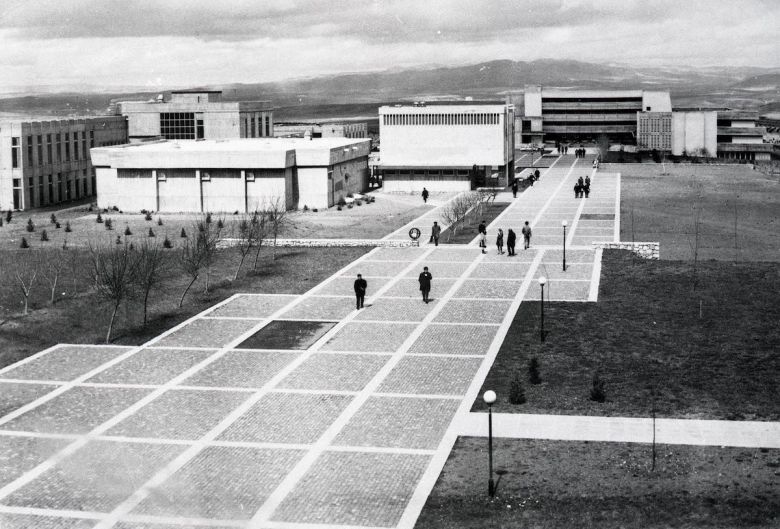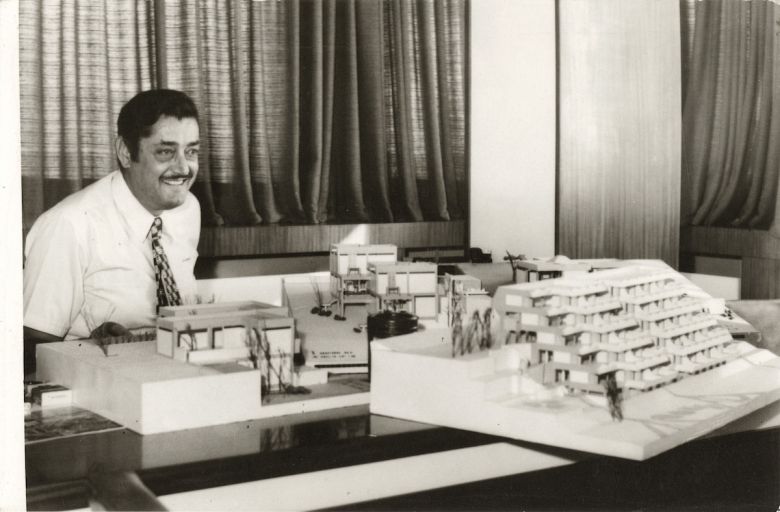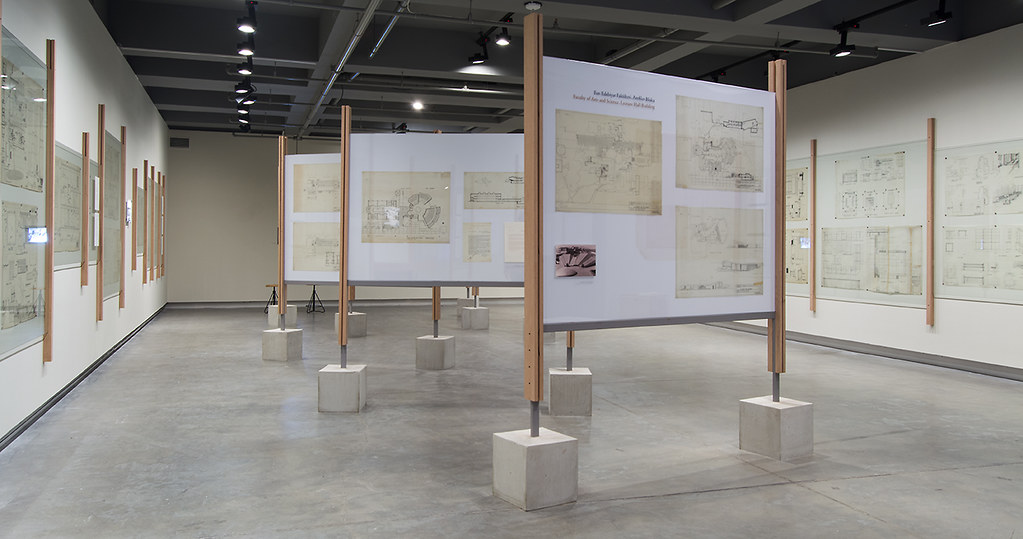Commissioners' Exhibition
Salt Galata
September 13 – November 26, 2017

METU pedestrian walkway, faculties of Architecture and Administrative Sciences in the background
SALT Research, Altuğ-Behruz Çinici Archive
SALT Research, Altuğ-Behruz Çinici Archive
Kemal Kurdaş was appointed president of the Middle East Technical University (METU) in Ankara on November 21, 1961. He met the winners of the design competition for the METU Campus, Altuğ Çinici and Behruz Çinici, for the first time on November 23. Kurdaş requested the immediate completion of the preliminary phase of architectural works, including the Faculty of Architecture building and two dormitories that had already been contracted. Simultaneously symbolic and essential to Kurdaş’s mission of establishing new life on the steppes surrounding the Eymir Lake, the first of tree planting events took place on December 3. Construction of the first buildings was put out to tender on February 1962, followed by the breaking ground ceremony on March 12. Kurdaş recalls this day in his memoirs:
“It was a spectacular ceremony. I delivered a highly daring speech. I said: ‘This horizontal building has 13,000 square meters of indoor area, and is a challenging construction. We will use a technique called exposed concrete for the first time ever in Turkey. We will complete the construction, which would normally take up to five-six years, during the summer next year […]. Then, I invite you here, to this building, for a cup of tea!’”*
Publicly launched with Kurdaş’s speech, the METU Campus project remained central to the career of Çinicis for nearly twenty years. This particular case displays how a commissioner contributes to the process of architectural production in all its complexity. The METU Collection, part of the Altuğ-Behruz Çinici Archive donated to SALT Research in 2015, comprises construction chronicles, building inspection agreements, work completion certificates, and official correspondence, in addition to project drawings. The comprehensive documentation of the project is evidence of the architects’ meticulous work ethics, and the tremendous support they gained from the president in return. It also reveals that a competent architectural production is dependent on a healthy environment of communication in which responsibilities are addressed fully and accurately by all parties.
Conceived by SALT, Commissioners’ Exhibition studies this critical relationship between the architect and the commissioner through a number of buildings contracted by private and public entities in Ankara, Çanakkale, Denizli, Izmir, and Istanbul from 1930s to 2010s. The selection focuses on commissioners’ influence over works of architecture with narrations featuring original archival documents and interviews. Their instrumental potential to initiate novelties, a much more important trait than the ability to provide resources, is argued via the personal archive of Özer Türk—a bureaucrat who vitalized early stages of tourism during his administrative posts across the Aegean between 1963 and 1975.
“It was a spectacular ceremony. I delivered a highly daring speech. I said: ‘This horizontal building has 13,000 square meters of indoor area, and is a challenging construction. We will use a technique called exposed concrete for the first time ever in Turkey. We will complete the construction, which would normally take up to five-six years, during the summer next year […]. Then, I invite you here, to this building, for a cup of tea!’”*
Publicly launched with Kurdaş’s speech, the METU Campus project remained central to the career of Çinicis for nearly twenty years. This particular case displays how a commissioner contributes to the process of architectural production in all its complexity. The METU Collection, part of the Altuğ-Behruz Çinici Archive donated to SALT Research in 2015, comprises construction chronicles, building inspection agreements, work completion certificates, and official correspondence, in addition to project drawings. The comprehensive documentation of the project is evidence of the architects’ meticulous work ethics, and the tremendous support they gained from the president in return. It also reveals that a competent architectural production is dependent on a healthy environment of communication in which responsibilities are addressed fully and accurately by all parties.
Conceived by SALT, Commissioners’ Exhibition studies this critical relationship between the architect and the commissioner through a number of buildings contracted by private and public entities in Ankara, Çanakkale, Denizli, Izmir, and Istanbul from 1930s to 2010s. The selection focuses on commissioners’ influence over works of architecture with narrations featuring original archival documents and interviews. Their instrumental potential to initiate novelties, a much more important trait than the ability to provide resources, is argued via the personal archive of Özer Türk—a bureaucrat who vitalized early stages of tourism during his administrative posts across the Aegean between 1963 and 1975.

Özer Türk, district governor of Burhaniye, with the scale model of Ar-Tur, 1970
Özer Türk Archive
Özer Türk Archive
Commissioners’ Exhibition delves into examples in Istanbul with documents from the renovation process of SALT Galata, and a constellation of structures commissioned by women patrons during the Ottoman Empire. This selection, ranging in scale from a fountain to expansive building complexes, is mapped across the city and and some are detailed with drawings, photographs, and written documents from SALT Research Ali Saim Ülgen Archive. Installed as a new city map, this study enables an examination of the role women patrons played in Istanbul’s urbanization from 15th to 20th century.
The exhibition suggests every noteworthy architectural endeavor is the result of a competent architect paired with an engaging commissioner. However, this relationship is often portrayed as antagonistic instead of being articulated as a common ground for production. In a considerably dominant perspective where the architect claims other experts and implementers as enemies of her/his design, the commissioner is caricatured as “ignorant and tasteless.” During the past forty years, globalization in architecture has manifested itself in the profile of the wandering “starchitect,” while the commissioner has represented a pragmatic type embedded in corporate investment and development schemes. In the face of world’s urgencies, architects are challenged to question the ways they have been practicing the profession. Commissioners’ Exhibition reminds that architects, while unearthing their potential to channel their skill, expertise and efforts from creating a masterpiece to enabling an environment of shared production, should also reconsider their perception of the commissioner.
Documents selected from the archives of Altuğ-Behruz Çinici, Cengiz Bektaş, and Ali Saim Ülgen are part of SALT Research Architecture and Design Archive supported by Kalebodur.
* Hayatım Mücadeleyle Geçti “Kemal Kurdaş Kitabı,” Interview by Şengün Kılıç Hristidis, Istanbul: Türkiye İş Bankası Kültür Yayınları, 2010
RESEARCH
Meriç Öner (SALT Research and Programs), Melis Cankara (SALT Research and Programs), N. Müge Cengizkan, Firuzan Melike Sümertaş, Murat Tülek, Işıl Uçman Altınışık (Pamukkale University), Murat Burak Altınışık (Pamukkale University), Ali Eray (PAB), Pınar Gökbayrak (PAB), Burçin Yıldırım (PAB), Beril Sarısakal (SALT Research and Programs), Masum Yıldız (SALT Research and Programs), Berin Ekici (PAB)
CONTRIBUTION
Can Çinici, Esat Sivri, Ediz Türk, Gülizar Özden Türk, Gülden Evirgen, Ersan Türk, Sezen Evirgen Öğücü, Ece Çokar, Emre Senan, Nevzat Sayın, Han Tümertekin, Zeynep Tümertekin, and METU Faculty of Architecture
DESIGN
PAB, Emirhan Altuner (SALT Research and Programs), Tuğrul Veli Şalcı (SALT Research and Programs)


